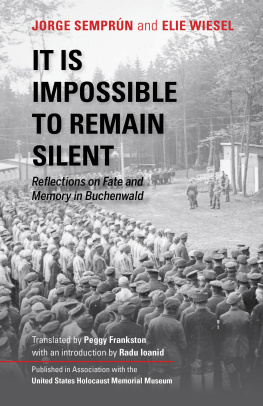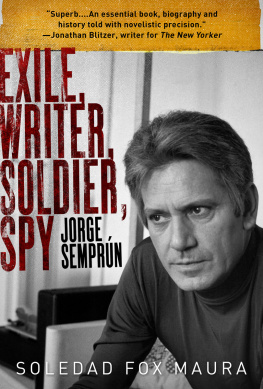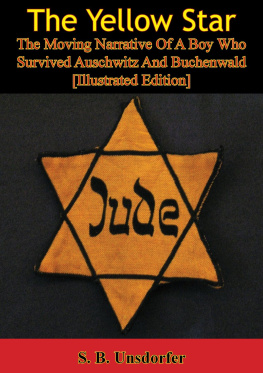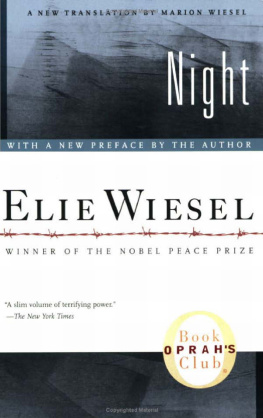
IT IS IMPOSSIBLE TO REMAIN SILENT
JORGE SEMPRN and ELIE WIESEL
IT IS IMPOSSIBLE TO REMAIN SILENT
Reflections on Fate and Memory in Buchenwald
Translated by Peggy Frankston
with an introduction by Radu Ioanid
Published in Association with the
United States Holocaust Memorial Museum
This book is a publication of
INDIANA UNIVERSITY PRESS
Office of Scholarly Publishing
Herman B Wells Library 350
1320 East 10th Street
Bloomington, Indiana 47405 USA
iupress.indiana.edu
English-language translation
United States Holocaust Memorial Museum, 2020
Published in Association with the
United States Holocaust Memorial Museum
First published in French as Se taire est impossible. Mille et une nuit, dpartement des ditions Fayard/Arte editions, 1995.
The assertions, arguments, and conclusions contained herein are those of the author or other contributors. They do not necessarily reflect the opinions of the United States Holocaust Memorial Museum.
No part of this book may be reproduced or utilized in any form or by any means, electronic or mechanical, including photocopying and recording, or by any information storage and retrieval system, without permission in writing from the publisher. The Association of American University Presses Resolution on Permissions constitutes the only exception to this prohibition.
Manufactured in the United States of America
Cataloging information is available from the Library of Congress.
ISBN 978-0-253-04528-7 (hardback)
ISBN 978-0-253-04529-4 (e-book)
1 2 3 4 525 24 23 22 21 20
CONTENTS
by Radu Ioanid
PUBLISHERS NOTE
On March 1, 1995, during the period when the fiftieth anniversary of the liberation of the Nazi camps was being commemorated, ARTE proposed an encounter between two highly regarded figures of our time, Elie Wiesel and Jorge Semprn, on its program Entretien (conversation).
These two men, whose destinies were unparalleled, had probably crossed paths, without ever meeting, in 1945 in the Nazi concentration camp Buchenwald.
In 1995 they met to evoke the experience they had shared, although it was different for each of them. During this encounter, they brought reflections and fundamental questions to the fore.
We felt that it was absolutely essential to make their voices heard, because if, in some sense, speaking about this subject is impossible, keeping silent should not be permitted.
Here is the entire transcription of the TV program Conversation between Elie Wiesel and Jorge Semprn, proposed by Klaus Wenger and Laurent Andres, directed by Stphane Loison, and broadcast on March 1, 1995.
. The French-German state-funded television network devoted to history, the arts, and politics. It is somewhat analogous to the Public Broadcasting Service (PBS) in the United States.
IT IS IMPOSSIBLE TO REMAIN SILENT
INTRODUCTION BY RADU IOANID
About Elie Wiesel
ELIE WIESEL AND JORGE SEMPRN INITIALLY HAD nothing in common. But destiny brought them together.
Wiesel was born in 1928 in Sighet, Romania, to a middle-class Jewish family. He spoke Yiddish, Hungarian, and Romanian. He studied the Talmud and dreamed of becoming a learned teacher of Kabbalah. Sensitive, with an inclination to ponder existential questions, Wiesel was a delicate human being from an early age. As a child and as a teenager, he suffered the consequences of Romanian and, later, Hungarian antisemitism.
On May 16, 1944, after being marked with the yellow star and interned for twenty-six days in the local ghetto, Wiesel was deported by the Hungarian gendarmerie. Together with his family, he was included in the first transport of the Jews of Sighet sent to Auschwitz. His mother, Sarah, and younger sister, Tzipora, were gassed upon arrival in the camp. Never shall I forget that smoke. Never shall I forget those flames that consumed my faith forever. Never shall I forget those moments that murdered my God and my soul and turned my
Having lied about his age, Wiesel was selected for work in Auschwitz and one of its subcamps, Monowitz. Robbed of everythingincluding his gold dental crownWiesel was put to work hauling stone blocks and loading motors onto train cars. He was beaten, starved, and forced to witness the executions of fellow inmates. He was evacuated from Auschwitz by the SS in the bitter cold of January 1945, first on foot and then in an open freight car. According to SS statistics, fifty-two inmates perished during this transport.
Encouraged by a 1954 conversation with French philosopher and Nobel Prize winner Franois Mauriac, Wiesel published the acclaimed autobiographical novel Night, first in Yiddish (1956), then in French (1958), and then in English (1960). Night was subsequently translated into more than thirty languages. Wiesel, who always wrote in French, authored more than sixty books and won prestigious literary awards such as the Prix Mdicis. He went on to hold the Andrew W. Mellon Professorship in the Humanities at Boston University. A dedicated humanist, Wiesel strongly defended the cause of the oppressed: Soviet Jews, indigenous peoples in Nicaragua, the disappeared in Argentina, Kurds in Iraq, and victims of apartheid in South Africa.
Wiesel was the founding chairman of the United States Holocaust Memorial Museum in Washington, DC, and in 1986 he was awarded the Nobel Peace Prize.
About Jorge Semprn
JORGE (GEORGES) SEMPRN WAS BORN IN 1923 IN Madrid to a well-established liberal Catholic family. He was tutored in the fine arts and literature. His maternal grandfather, Antonio Maura, served as the prime minister of Spain more than once, and his father, Jos, a distinguished lawyer, represented Republican Spain as its top diplomat in the Netherlands during the Spanish Civil War. Because of this Republican allegiance, the family found itself in exile as early as 1936. In 1939, Semprns parents sent him to study in Paris at the prestigious Lyce Henri-IV.
A member of the French communist resistance, Semprn was arrested by the Gestapo on October 8, 1943, in Joigny, France. He was imprisoned first in Auxerre, where he was tortured, and later in Dijon and the Royallieu camp in Compigne. On January 27, 1944, he was deported as a political prisoner in a freight car to the German concentration camp Buchenwald. He was liberated at this camp on April 11, 1945.
After liberation, Semprn worked for UNESCO. Starting in 1953, he lived and worked in Madrid as a high-ranking clandestine organizer for the banned Spanish Communist Party. In 1964, he was expelled from the party for disagreeing with its sectarian leadership in exile.
After his return to France, Semprn published several books related to his experiences as an inmate in Buchenwald (Le grand voyage and Lvanouissement); his experiences as an underground leader (Autobiografia de Frederico Sanchez); and his views on Stalinism (La deuxieme mort de Ramn Mercader). Completely trilingual in Spanish, French, and German, Semprn worked with distinguished directors on several important films dealing with crimes of fascism and Stalinism. Among the films were Alain Resnaiss La guerre est finie and Costa-Gavrass Z and LAveu. Z, which won the Jury Prize at the 1969 Cannes Film Festival and the Oscar for Best Foreign Film in 1970, told the story of a political murder by the Greek military dictatorship;
Next page








